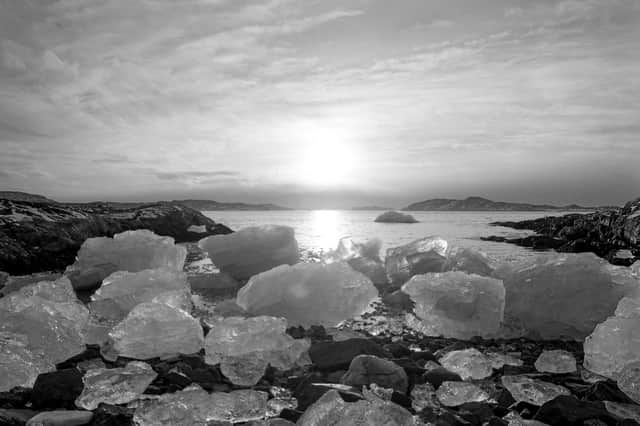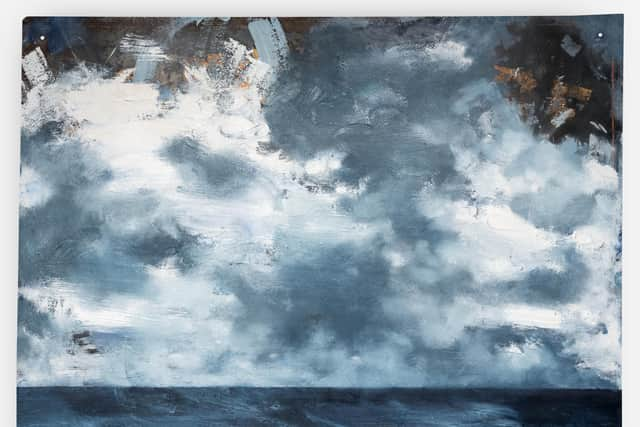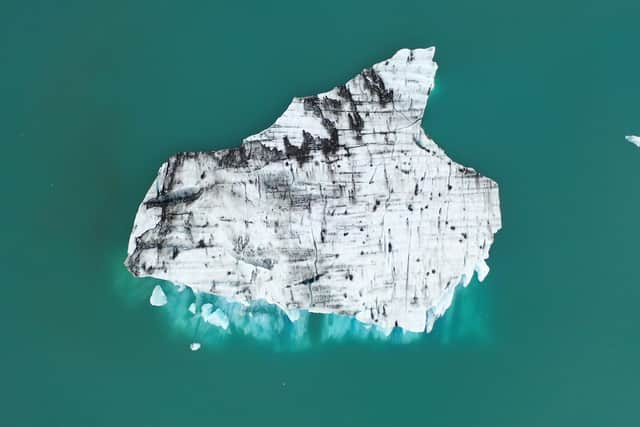Lockdown photo project brings the perils of sea level rise into sharp focus


Back in the innocent, pre-covid days of January 2019, when visiting an art gallery didn't involve booking an appointment in advance and donning a hazmat suit on arrival, The Scottish Gallery in Edinburgh hosted an intriguing exhibition by ECA-trained artist David Cass. Titled Rising Horizon, it mostly consisted of empty seascapes painted onto a variety of found objects, from old tins and trays to shop signs, road signs and even – memorably – a large copper boiler.
The idea of a marine artist painting directly onto found objects isn't new – for many years now, the Exmouth-based sailor and artist Graham Rich has been creating atmospheric nautical scenes on flotsam washed up by the tide, each one featuring a tiny representation of his sailing boat, Jouissance. But while Cass's unconventional use of second-hand canvases wasn't necessarily original, what he chose to paint on them definitely was.
Advertisement
Hide AdWith climate change and rising sea levels foremost in his mind, Cass titled each work after the approximate percentage of the painting surface that was covered by water. So, in a work called Horizon 18% (oil on fire station sign), the horizon line only extends about a fifth of the way up the picture, with a dramatic cloudscape billowing above. By contrast, in Horizon ~89% (oil on pastilles tin), the sky appears as a thin strip at the top of an otherwise entirely watery image. The cumulative effect of the exhibition was to make the viewer subtly but constantly aware of sea level, not as an immutable thing – the mean high water mark that appears on Ordnance Survey maps – but as something that is in a constant state of flux.


The choices of found object often felt significant, too: the metal road signs and petrol station signs spoke directly to the burning of fossil fuels that lies behind global warming and the consequent sea level rise that already threatens coastal communities, while the shop signs and vintage packaging seemed like relics of the rampant consumer culture which has also played a role in the current crisis.
In addition to his "percentage paintings" (my name for them, not his), Cass's Scottish Gallery show also included two series of paintings named after the seas and oceans of the world; the first group, painted onto the tops or sides of second-hand tins, had titles like Caspian, Laptev and Red; the second, painted onto the tops of stacks of circular found objects, were titled Pacific, Arctic, Indian and so on. Collectively, they served as a reminder that, while sea level rise will affect some parts of the globe more than others, it is a truly global problem; and that same message comes across loud and clear in Cass's latest project, an ambitious online exhibition which will be available to view in its entirety from Wednesday, although some of it is already live.
Titled The Sea From Here, the project brings together photographs of the sea taken during lockdown by "sea people" all around the world, supplemented with brief, thought-provoking texts concerning sea level rise written by oceanographer John Englander. Scotsman readers may recognise the pictures taken from South Queensferry, Yellowcraigs Beach in East Lothian or Talisker Bay on the Isle of Skye, but this is a truly international project, and there are also images from Cannes, Barcelona, Uummannaq in Greenland, Bruny Island in Tasmania and the Gulf of Riga in Latvia.
In the spring of 2020, finding himself locked down in his central London flat, Cass put out an open call for "people who lived by the sea, or found themselves on a coast at the point of lockdown, to send me their view, without going out of their way to do so, or disobeying rules of social distancing; whether this was the sea they saw from the foot of their garden, or a phone-snap taken whilst out walking." He received some notable contributions from some notable contributors: the academic David Gange, whose excellent book about kayaking the length of the British Isles, The Frayed Atlantic Edge, was reviewed in these pages the year before last, sent a dramatic picture of storm surf crashing against rocks off Golam Head near Connemara; long-distance swimmer Katie Mcalister sent pictures from a cross-Channel relay race; artists Alessa Brossmer and Jochen Orso sent an aerial image of an iceberg on the Jökulsárlón lagoon in Iceland, where they had been recording melting bergs.


The work is all very slickly presented, and the accompanying texts by Englander, while brief, still provide plenty of food for thought. One begins: “Higher sea levels will gradually reshape coastlines all over the world” – and you can’t help wondering how different some of the places featured in this exhibition might look in 100 years’ time.
Advertisement
Hide AdTo view the online exhibition, The Sea From Here, visit https://davidcass.art/theseafromhere. Further work will be added from Wednesday 7 April.
A message from the Editor
Thank you for reading this article. We're more reliant on your support than ever as the shift in consumer habits brought about by coronavirus impacts our advertisers.
If you haven't already, please consider supporting our trusted, fact-checked journalism by taking out a digital subscription at https://www.scotsman.com/subscriptions